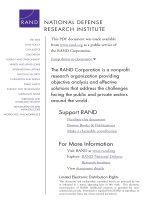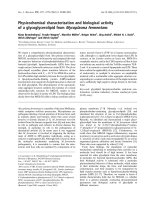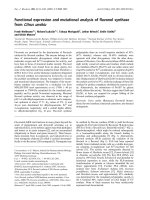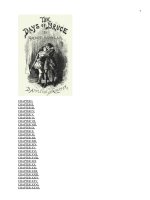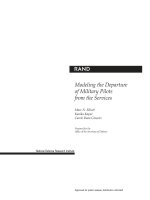Modeling the Departure of Military Pilots from the Services ppt
Bạn đang xem bản rút gọn của tài liệu. Xem và tải ngay bản đầy đủ của tài liệu tại đây (401.59 KB, 86 trang )
National Defense Research Institute
Modeling the Departure
of Military Pilots
from the Services
Marc N. Elliott
Kanika Kapur
Carole Roan Gresenz
Prepared for the
Office of the Secretary of Defense
Approved for public release; distribution unlimited
R
The research described in this report was sponsored by the Office of the Secretary
of Defense (OSD). The research was conducted in RAND’s National Defense
Research Institute, a federally funded research and development center supported
by the OSD, the Joint Staff, the unified commands, and the defense agencies under
Contract DASW01-01-C-0004.
RAND is a nonprofit institution that helps improve policy and decisionmaking
through research and analysis. RAND
®
is a registered trademark. RAND’s pub-
lications do not necessarily reflect the opinions or policies of its research sponsors.
Published 2004 by RAND
1700 Main Street, P.O. Box 2138, Santa Monica, CA 90407-2138
1200 South Hayes Street, Arlington, VA 22202-5050
RAND URL: />To order RAND documents or to obtain additional information, contact Distribution
Services: Telephone: (310) 451-7002; Fax: (310) 451-6915; Internet:
© Copyright 2004 RAND
All rights reserved. No part of this book may be reproduced in any form by any
electronic or mechanical means (including photocopying, recording, or information
storage and retrieval) without permission in writing from RAND.
Library of Congress Cataloging-in-Publication Data
Elliott, Marc N., 1966–
Modeling the departure of military pilots from the service / Marc N. Elliott,
Kanika Kapur, Carole Roan Gresenz.
p. cm.
“MR-1327-OSD.”
Includes bibliographical references.
ISBN 0-8330-2976-2
1. Air pilots, Military—Job satisfaction—United States. 2. Air pilots, Military—United
States—Retirement. 3. United States. Air Force—Appointments and retirements. 4. United
States. Air Force—Officers. I. Kapur, Kanika. II. Gresenz, Carole Roan, 1969– III. Title.
UG793 .E45 2001
358.4'114'0973—dc21
2001019039
iii
Preface
This study evaluates the effects of hiring by major airlines and changes in
military compensation on the voluntary departure of male pilots from the Air
Force, Navy, and Marine Corps. Our results should be of interest to those
concerned about pilot attrition, as well as the larger defense manpower research
community, and those interested in the modeling of pilot attrition. We assume
that readers will have some familiarity with linear regression techniques.
This analysis was conducted between 1998 and 2000. The information on
compensation and bonuses reflects the situation at the time the analysis was
conducted, and some of the specific figures may no longer be accurate.
Regardless, the general results about the relationship between hiring in the
airline industry and military pilot retention are still relevant.
This report was prepared under the sponsorship of the Office of the Secretary of
Defense, Personnel & Readiness. It was prepared within the Forces and
Resources Policy Center of the RAND National Defense Research Institute, a
federally funded research and development center sponsored by the Office of the
Secretary of Defense, the Joint Staff, the unified commands, and the defense
agencies.
v
Contents
Preface iii
Figures vii
Tables ix
Summary xi
Acknowledgments xiii
1. INTRODUCTION 1
2. CAREER PATHS OF PILOTS IN THE MILITARY AND CIVILIAN
AIRLINES 5
Military Careers 5
Active Duty Service Obligation 5
Earnings of Aviation Officers 6
Civilian Careers 9
The Commercial Airline Industry 10
Joining the Commercial Airlines: When? 12
3. BEHAVIORAL MODEL AND DATA 17
The Approach of This Study 17
Military Data and File Construction 18
Limitations of the Data 20
Levels of Attrition at ADSO 23
Civilian Data 25
Issues in Specification of the Pilot Attrition Model 26
Dependent Variable 26
Independent Variables 27
Military and Civilian Opportunities 31
Construction of Estimated Military Pay Profiles 33
Civilian Pay Profiles 33
4. MODEL RESULTS AND SENSITIVITY ANALYSES 35
5. DISCUSSION AND CONCLUSION 43
Appendix
A. OFFICER PROMOTION PATHS 45
Promotion Rates and Timetables 45
Responsibilities over a Career 45
B. PREVIOUS APPROACHES TO ESTIMATING MODELS OF
AVIATOR ATTRITION 47
Models Using Aggregate Data and/or Military/Civilian Pay
Ratios 47
Cost of Leaving Models 48
Dynamic Retention Models 50
Other Models of Attrition 51
vi
C. CONSTRUCTION OF EXPECTED MILITARY PAY PROFILES 55
D. CONSTRUCTION OF ALTERNATIVE SPECIFICATION CIVILIAN
PAY PROFILES 61
Earnings Data 61
Differences in Earnings Among Types of Carriers 62
Major/Regional Data 64
Specifics on Earnings Profiles in the Majors 64
Specifics on Earnings Profiles in the Regionals 65
Bibliography 67
vii
Figures
1.1. Voluntary Attrition of Military Airplane Pilots by Year of Loss 1
2.1. Cumulative Attrition as a Percentage of Initial Cohort Size, 1981
Air Force Entry Cohort 6
2.2. Civilian Major Airline Hires by Year of Hire 12
2.3. Civilian Major Airline Hires and Military Pilot Attrition by Year
of Loss 13
2.4. Idealized Decision Tree for Pilot Career Path 14
2.5. Air Force Pilot Pay Profiles, 1987 Entry Cohort 15
3.1. Cumulative Attrition as a Percentage of Initial Cohort Size, 1981
Air Force Entry Cohort 22
3.2. Attrition During ADSO Window by Service Entry Cohort 23
3.3. U.S. Air Force ACP Officers and Pilot Attrition During ADSO
Window by Decision Year 24
ix
Tables
2.1. Compensation for Undeployed, Male, Married O3, 1987 Air
Force Cohort, Without Aviation Pays (in 1997 Dollars) 7
2.2. Aviation Continuation Pay Rules by Service 9
2.3. Compensation for Undeployed, Male, Married O3, 1987 Air
Force Cohort, Without Aviation Pays (in 1997 Dollars) 10
3.1. Decision YOS for Airplane Pilots by Cohort Year 22
4.1. Probit for Attrition of Pilots 37
4.2. Means and Standard Deviations of Independent Variables in
Primary Model 38
4.3. Means and Standard Deviations of Other Variables of Interest 38
4.4. Projections: Expected Percentage Point Change in Attrition
During the ADSO Window Corresponding to Changes in a
Single Independent Variable 39
4.5. Specification Checks and Their Results 41
xi
Summary
High numbers of voluntary departures from the services by military pilots have
periodically caused considerable concern among military administrators and
policymakers, both recently and in previous periods of high attrition.
1
In this
study, we explore some determinants of the fixed-wing (airplane) pilot attrition
problem among male pilots in the Air Force, Navy, and Marine Corps
2
and the
responsiveness of attrition to changes in military compensation.
We estimated a pilot attrition model that examines the impact on attrition from
factors such as compensation, deployment, voluntary separation programs, and
civilian airline hiring. Data sources include military personnel files and
information on civilian airline hiring and compensation.
The model is simplified in order to abstract from complex modeling issues, such
as the existence of multiple decision points and bonus contracts of differing
lengths. We focus on voluntary attrition within a few years of the end of the
initial service obligation. Although we were able to verify the insensitivity of our
results to a number of specification and sample checks, our results do depend on
a number of simplifying assumptions that may not be fully testable. Results from
the pilot attrition model should therefore be interpreted in light of these
assumptions.
This study produced several noteworthy findings, a summary of which follows:
We find that increases in major airline hiring tend to increase military pilot
attrition to a great degree in the Air Force and to a lesser extent in the Navy. A
difference of 2,500 total hires by the major civilian airlines (from all sources,
military and non-military) represents the difference between a year with
moderate hiring, such as 1986 or 1988, and a more extreme year in terms of
hiring, such as 1989 (a year with many hires) or 1983 (a year with few hires). In
our data, an increase of 2,500 airline hires was associated with a 35 percentage
point increase in attrition among Air Force pilots and an 11 percentage point
_________________
1
The term “attrition” as used in this report refers to a pilot’s voluntary departure from military
service.
2
Note that female, warrant officer, and reserve pilots were not included in the present analysis.
Small sample sizes prevented precise estimation of attrition of female pilots.
xii
increase among Navy pilots. This finding is particularly noteworthy given the
projected long-term increases in major airline hiring.
Although attrition was found to be quite responsive to bonus pay, the magnitude
of the effect of major airline hiring on attrition could make counteracting a
significant increase in major airline hiring a costly endeavor, particularly for the
Air Force.
The significant influence of civilian major airline hiring on military pilot attrition
necessitates the development of a military hiring plan that will enable the armed
forces to respond to strong exogenous influences. This situation also underlines
the importance of incorporating reliable forecasts of major civilian airline hiring
into a military pilot hiring plan.
Both the pay profile and lifestyle offered by the major civilian airlines contrast
sharply with those of their military counterparts. Although the present research
establishes a strong association between the availability of major civilian airline
jobs and military pilot attrition, this research cannot disentangle the
contributions of major airline pay and lifestyle to this association. Future research
might include survey components that would disentangle these elements of the
civilian airline job. Such research might suggest ways in which the military could
supplement changes in compensation in order to respond to the challenges
presented by the major civilian airlines.
xiii
Acknowledgments
We are indebted to Susan Hosek for her guidance throughout this project.
Reviewers John Ausink and Ron Fricker provided very helpful comments. We
have also benefited from the comments of Beth Asch, Richard Buddin, Jim
Hosek, Rebecca Kilburn, Harry Thie, Paul Hogan, Casey Wardynski, Megan
Beckett, and Al Robbert. We are also grateful to Jennifer Kawata, Lee Mizell, and
Bill Taylor for their contributions to a previous draft of this report. Defense
Manpower Data Center, Kit Darby (AIR, Inc.), Micki Fujisaki, Carol Edwards,
and Mark Totten helped extract and format data used for analyses in this report.
Jerene Kelly, Pamela Thompson, and Nora Wolverton provided valuable help in
preparing the manuscript. Gordon Lee was instrumental in organizing and
editing the report. We’d also like to thank Nancy DelFavero for her excellent
editing work on this report. Finally, we would like to thank our project monitor,
Saul Pleeter, for his support and comments in conducting this study and
preparing this report.
xv
Acronyms
ACIA-89 Aviation Career Incentive Act of 1989
ACIP Aviation career incentive pay
ACOL Annualized cost of leaving
ACP Aviation continuation pay
ADSC Active duty service commitment
ADSO Active duty service obligation
AOCP Aviation officer continuation pay
BAH Basic allowance for housing
BAQ Basic allowance for quarters
BAS Basic allowance for subsistence
CBO Congressional Budget Office
CNA Center for Naval Analyses
CONUS Continental United States
DMDC Defense Manpower Data Center
DoD Department of Defense
DOPMA Defense Officer Personnel Management Act of 1980
DOT U.S. Department of Transportation
FAE Final average earnings
FAPA Federal Aviation Pilot Association
FSA Family separation allowance
FY Fiscal year
HDP Hazardous duty pay
xvi
HFP Hostile fire pay
HYOT High year of tenure
IDP Imminent danger pay
NDAA National Defense Authorization Act
OCS Officer Candidate School
PDV Present discounted value
SSB Special Separation Benefit Program
TCOL Total cost of leaving
UPT Undergraduate pilot training
VHA Variable housing allowance
VSI Voluntary separation incentives
YOS Years of service
1
1. Introduction
High levels of military pilot attrition have periodically caused considerable con-
cern among military administrators and policymakers, both recently and in pre-
vious periods of high attrition. Pilot attrition is not only costly to the services in
terms of the lost investment in training departed pilots, but can also deplete the
ranks of veteran pilots to an extent that it affects the training of their replace-
ments. As shown in Figure 1, the level of voluntary attrition varies considerably
over time.
1
This variability makes it difficult to manage pilot assignments and
maintain a pipeline of properly trained and experienced pilots.
0
500
1,000
1,500
2,000
2,500
Number of Pilots Lost
Year of Loss
8980 81 82 83 84 85 86 87 88 90 91 92 93 94 95 96 97
Total
Navy
Marines
Air Force
RAND
MR1327-1.1
Figure 1.1—Voluntary Attrition of Military Airplane Pilots by Year of Loss
2
This report examines the factors affecting airplane pilot attrition from the ser-
vices and is especially concerned with estimating how compensation may affect
attrition. In particular, the large salaries (as much as $180,000 annually) and re-
tirement lump-sum payments (as much as $1 million) offered by major commer-
_________________
1
The large increase in the number of Navy pilots with voluntary attrition from 1987 to 1988
reflects substantial increases in the size of Navy pilot cohorts from 1980 to 1982.
2
Airplane pilots are very uncommon in the Army, and are therefore omitted from the figure and
all analyses. As noted earlier in this report, female, warrant officer, and reserve pilots are excluded
from analysis in this study.
2
cial airlines are often thought to greatly influence pilots' decisions near the end of
their initial service obligations. Therefore, the primary focus in this study is on
hiring by major airlines and the pilot compensation systems that the military has
designed in response to this airline hiring.
This study began in 1998. At that time, we conducted a series of interviews with
service representatives responsible for pilot management and compensation. We
used those interviews to clarify the extent of the pilot attrition problem and
identify important perceived influences on attrition. We then developed a brief
overview of pilots' careers in the services. Institutional constraints and policies
are critical to the timing of a pilot's decision to leave or stay in military service;
therefore, understanding these factors is integral to understanding pilots'
behavior.
Service representatives reported that their greatest attrition problems were with
airplane pilots. Other aviation officers had lower rates of attrition because of
lesser opportunities with commercial airlines.
3
All the service representatives pointed to multiple causes of attrition, including
dissatisfaction with aspects of a military career combined with enhanced op-
portunities in the civilian world, especially with commercial airlines. High oper-
ational tempo, less-enjoyable activities and missions, and the sense that military
careers are likely to become less appealing in the near future were commonly re-
ported as sources of dissatisfaction with the military.
A Fiscal Year (FY) 1996 Air Force survey of pilots in the National Guard who had
left active duty service in FYs 1991 to 1996 (Roeder, 1998) revealed that commer-
cial airline hiring and the length of Air Force bonus commitments were the most
important reasons given for leaving the service. A survey the following year of
Air Force aviators who had just elected to leave active duty service (Roeder,
1998) found that operational tempo and quality of life were the most common
reasons cited for their decision.
The effect of previous low attrition may also play an important role in the recur-
rent attrition problems. In 1994, the Air Force had record low attrition, partly a
consequence of its “feet on the ramp” policy. The policy stigmatized and penal-
ized those pilots who declined to accept a signing bonus that commits them to
additional service by immediately eliminating their flying opportunities (and
therefore limiting the recent flying experience that is important in airline hiring)
________________
3
For example, whereas airplane pilot attrition at the end of an initial obligation in the Air Force
was greater than 40 percent in our sample, navigator attrition was 31 percent at 9 years in the Air
Force and rotary-wing attrition was 20 percent at 6 years in the Army.
3
and giving them undesirable jobs. This policy may have resulted in the retention
and accumulation of personnel with no large preference for military service and
who would have otherwise left, and may have set the stage for a sudden jump in
the exit rate once external opportunities improved.
A 1996 to 1997 exit survey of Marines (Middlebrook, 1998) targeted departing F-
18 pilots who showed an especially high rate of attrition. They cited four main
reasons for leaving: discrepancies in bonus compensation for pilots (compared
with other services), overly high operational tempo, distrust of leadership at the
Department of Defense (DOD) level, and favorable commercial airline
opportunities. Navy representatives cited dissatisfaction with discrepancies in
bonus pay among Navy pilots.
In these qualitative interviews, we identified several factors that could poten-
tially affect pilot attrition:
• earnings opportunities in the civilian market relative to military pay
• operational tempo
• frequency of deployment
• adequacy of flying hours available to pilots
• the type of flying available (with peacekeeping missions generally viewed as
being less desirable than training)
• dissatisfaction with the disparity in bonus pay among military pilots
• the length of time it takes to become fully trained (which is affected by the
attrition in prior cohorts)
4
• attitudes toward leadership in higher echelons.
As will be discussed later in this report, not all of these factors will be measurable
in an empirical model. The empirical model therefore will be based only on a
subset of these factors.
The primary emphasis of this report is in understanding the roles of bonus pay
and civilian airline hiring in pilot attrition; other factors are used in the models
primarily to help isolate the effects of these two factors of special interest.
With this background information in hand, we turned to the primary quantita-
tive analysis of the problem and to gathering data on the career paths of pilots,
_________________
4
This leaves fewer senior pilots who can offer training, which then limits the training newer
pilots receive, which in turn affects promotion opportunities and delays the career track of newer
pilots.
4
modeling their decisions, and estimating the model to identify crucial factors in
their decisionmaking. In the following chapters, we summarize the data used in
our analysis, describe our attrition model specifications, and provide results from
the attrition estimation.
5
2. Career Paths of Pilots in the Military
and Civilian Airlines
Although the career paths of aviation officers are similar in many respects to
those of other officers, several aspects of their career development are notably
different. This chapter outlines typical pilot career paths and calls particular
attention to aspects of pilot career development that are unique to aviation
officers.
1
Military Careers
In the following sections, we describe the service obligations for the cohorts we
studied and describe the sources and levels of pay for military pilots.
Active Duty Service Obligation
Following their training period, which generally takes about two years, all pilots
incur an obligation of service that starts the moment training is concluded.
2
The
active duty service obligation (ADSO), known in the Navy as the active duty
service commitment (ADSC), is incurred through pilot training and is the
amount of time pilots must serve after that training before they can voluntarily
depart the services.
For the cohorts we studied, who entered service between 1977 and 1989, the
length of this obligation ranged from 4.5 to 8 years for the Air Force, Navy, and
Marines. The ADSO has lengthened over time, but has generally been longest in
the Air Force and shortest in the Marines.
As can be seen in Figure 2.1, almost all the attrition that occurs before the
standard retirement at 20 years of service (YOS) occurs near the end of the
ADSO. In the example in the figure, the ADSO was six years; therefore, with
two years of training, the ADSO would generally fall at 8 YOS. Note that in this
representative sample, virtually all voluntary attrition occurs between 6 YOS
_________________
1
A brief summary of military officer promotion paths and responsibilities is in Appendix A.
2
This obligation is an extension of the initial service obligation with which most officers enter
active duty.
6
0%
10%
20%
30%
40%
50%
60%
70%
Year
Estimated ADSO Year
(with two years training)
YOS
Cumulative Attrition
RAND
MR1327-2.1
2345678910111213141516
Years of Service/Year
1983
1993 19971988
Figure 2.1—Cumulative Attrition as a Percentage of Initial Cohort
Size, 1981 Air Force Entry Cohort
3
and 10 YOS, a five-year window surrounding estimated or average ADSO for
that cohort.
Earnings of Aviation Officers
Like other officers, aviation officers are entitled to Basic Pay, Basic Allowance for
Subsistence (BAS), and Basic Allowance for Housing (BAH). BAH replaces the
former Basic Allowance for Quarters (BAQ) and Variable Housing Allowance
(VHA).
4
Officers’ earnings also may include special types of pay for particular
circumstances.
Not all pilots receive all the possible types of pay. For example, extended time
away from home yields a Family Separation Allowance (FSA), and subjection to
hostile fire or service in an area defined as being hostile results in the payment of
Imminent Danger Pay (IDP), formerly known as Hostile Fire Pay (HFP) or
Hazardous Duty Pay (HDP). These components currently sum to a total
________________
3
Note that cumulative attrition reaches an asymptote at the proportion of the cohort that stays
until retirement.
4
Whereas VHA existed for all officers in our sample, it should be noted that this form of pay no
longer exists.
7
compensation of approximately $53,000 for undeployed officers at the end of the
initial obligation. In addition, aviation officers are entitled to the same retirement
benefits as other officers. Table 2.1 illustrates these pay components (in 1997
dollars) for an undeployed, male, married, fixed-wing pilot with a rank of O3
from the 1987 Air Force cohort, completing ADSO in 1995.
One of the most important features of the military retirement system is its “cliff
vesting.” Military members receive no retirement benefit if they leave before YOS
20; after 20 years of service, service members are entitled to the full retirement
benefit. The actual benefit varies by entry (accession) cohort, but is the same for
all officers within a cohort.
5
Cliff vesting is responsible for the very low rate of
voluntary attrition in the years immediately prior to 20 YOS.
Table 2.1
Compensation for Undeployed, Male, Married O3,
1987 Air Force Cohort, Without Aviation Pays (in
1997 Dollars)
Basic Pay 39,206
BAS 1,847
BAQ 7, 382
VHA 657
Tax advantage 3, 845
Total 52,937
Pilots are also potentially eligible for two other types of pay. The first is
commonly known as “flight pay” and formally known as Aviation Career
Incentive Pay (ACIP). ACIP was first instituted in 1913 and since then has
undergone a series of changes. ACIP varies by YOS but not by rank, and ranges
from a low of $125 per month for pilots with little aviation experience to a
maximum of $650 per month for pilots with 6 to 18 YOS.
6
ACIP decreases among
those with more than 18 YOS, declining over time from $585 to $250 per month.
The maximum amount of flight pay is designed to coincide with the end of the
initial ADSO when pilots must make a decision about whether to stay in the
military or leave (Riebel, 1996). The amount of ACIP is fixed in dollar terms and
is not indexed to inflation. Therefore, the actual value of ACIP erodes over time
with inflation. For instance, ACIP payments were set in 1981 and not changed
_________________
5
Retirement benefits vary depending on whether entry was before September 8, 1980, between
September 8, 1980, and August 1, 1986, or after August 1, 1986. The retirement benefit provisions are
outlined in Ausink (1991).
6
As of late 2001, the maximum ACIP had been increased to $840 per month.
8
again until 1991. From 1981 to 1989, the value of ACIP decreased about 30
percent (U.S. Congressional Budget Office, 1989).
7
To receive ACIP, pilots must “meet their gates,” that is, they must have a
minimum number of years of flight experience at certain checkpoints.
Specifically, at YOS 12, officers must have 8 years of operational flying to receive
ACIP through year 18; at YOS 18, officers must have 10 years of operational
flying to receive ACIP through year 22, and must have 12 years of operational
flying to receive ACIP through year 25.
8
Only pilots who remain in operational
flying positions continue to receive ACIP after YOS 25. The hypothetical officer
in Table 2.1 would receive $8,215 in ACIP, for a total compensation of
approximately $61,000 at ADSO.
The second type of pay to which only aviators have access is Aviation
Continuation Pay (ACP). ACP was instituted in 1989 and is a bonus used to
entice aviators to remain in the service after they meet their initial ADSO.
9
Aviators must sign a contract committing to additional service to receive this
bonus. Aviators must be at or below the grade of O6, have completed the ADSO
associated with their undergraduate aviator training, and have at least 6 years of
aviation service but not more than 14 years of commissioned service to be
potentially eligible for the bonus. Each service decides on the specifics of ACP
implementation. Table 2.2 summarizes the current features of the bonus system
by service.
The services have changed their implementation of ACP somewhat over time,
and recently service-wide provisions regarding ACP have been changed. In
particular, the maximum bonus that the services are allowed to offer for a long-
term contract increased from $12,000 to $25,000 annually (although no service
has implemented more than a $22,000 bonus), and the maximum bonus allowed
for a short-term contract rose from $6,000 to $12,000. The new provisions also
granted authority for a three-year contract.
________________
7
Prior to 1991, ACIP amounts ranged from $1,500 to $4,800 per year ($125 to $400 per month).
The new provisions were set forth in the Aviation Career Incentive Act of 1989 (ACIA-89), which was
incorporated into the National Defense Authorization Act for Fiscal Year 1990. ACIA-89 provisions
became effective October 1, 1991.
8
Prior to implementation of the ACIA-89, the gates were 6 flying years by YOS 12 to receive
ACIP through the 18th year, 9 flying years by YOS 18 to receive ACIP until year 22, and 11 flying
years by YOS 18 to receive ACIP until year 25 (Heinen, 1990). A transitional system was applied for
those who were assessed between 1979 and 1985.
9
Prior to 1989, aviators in the Navy were eligible to receive AOCP, or Aviation Officer
Continuation Pay. From 1981 through 1982 and in 1984 all Naval aviators were eligible for AOCP,
whereas from 1985 through 1988 AOCP was targeted to communities with shortages. Aviators in the
Marine Corps were eligible for AOCP in 1981 and 1984.
9
Table 2.2
Aviation Continuation Pay Rules by Service
Air Force Navy Marines
Eligibility
a
Offered to all airplane pilots
Targeted to a varying subset of airplane pilot
communities
√√
Term of Contract
Long-term only
√
Long- and short-term
√√
Amount
$6K to $22K, depending on contract length
√
$10K to $19K, depending on community
√
$12K for long term
√
a
All services make ACP eligibility available when the O1 to O5 pilot requirements exceed O1 to O5
pilot inventory. The Air Force assesses this at an aggregate level (therefore making all airplane pilots
eligible since the institution of ACP and all pilots eligible since FY 1996), whereas the Navy assesses
shortages by community.
Prior to the changes, the Air Force offered annual payments to pilots ranging
from $6,500 to $12,000 depending on contract length, and the Navy offered
annual payments from $6,000 to $12,000 depending on community. The Marines
have replaced short-term contracts with longer-term contracts. The amount of
ACP offered has increased in “stair steps,” with erosion in real value between
those increases. Each increase has, however, greatly increased the real value of
ACP from its previous high.
Table 2.3 adds ACP and ACIP (in inflation-adjusted 1997 dollars) to the non-
aviation pays for the hypothetical fixed-wing pilot of Table 2.1, assuming he
chose the lump-sum ACP option in the year after ADSO. Total compensation that
year is approximately $99,000.
Civilian Careers
In the following sections, we describe the different commercial airline types and
the salary opportunities within those groups, provide information on civilian
airline hiring levels, and describe the financial implications of a pilot’s career
decisions.
